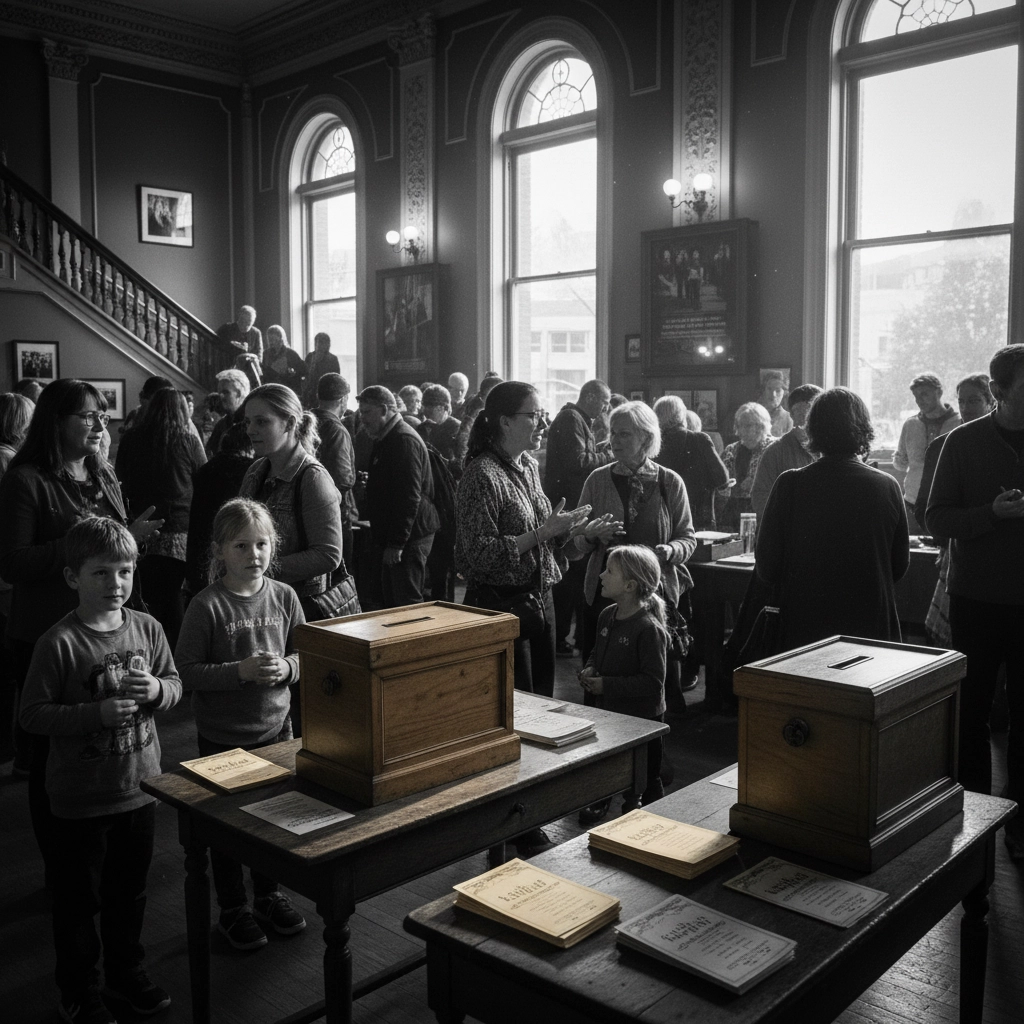Struggling For Theatre Program Funding? 50+ Creative Advocacy Examples That Actually Work
- Anthony Cimino-Johnson
- 4 days ago
- 5 min read
Look, I get it. You're running a theatre program with the passion of Shakespeare and the budget of a community garage sale. Every season feels like a high-wire act where one funding cut could bring down the curtain permanently. But here's what I've learned after years in this business: the most successful theatre programs aren't just great at putting on shows: they're masters at telling their story to the people who matter most.
The good news? Theatre programs across the country have cracked the code on creative advocacy that actually works. These aren't theoretical strategies from some ivory tower consultant. These are real tactics used by real programs facing real budget pressures, and they're getting real results.
The Power of Strategic Coalition Building
Partner Up, Don't Go Solo
Minnesota Opera figured this out years ago when they started partnering with Minnesota Citizens for the Arts. Instead of fighting for funding alone, they joined forces with other arts organizations to create a unified voice that legislators couldn't ignore. Their approach? Pool resources with statewide lobbying groups that collectively press for arts funding.
But they didn't stop there. Minnesota Opera also partnered locally through St. Paul's Arts Partnership: a collaboration between four performing organizations at the Ordway Center. They pool their efforts to raise money from both public and private sources, essentially creating a funding machine that's bigger than any single organization could build alone.
The Role-Based Lobbying Revolution
Opera Theatre of Saint Louis took coalition building to the next level with something I've never seen before: role-based lobbying teams. Instead of sending the same theater director to every meeting, they organized teams across arts organizations by specific roles: operations people, education program leaders, working artists, and fundraising professionals.

Why does this work so brilliantly? Because when legislators hear from a diverse group of arts professionals, they understand the full ecosystem impact. It's one thing for a director to say "fund the arts." It's completely different when an operations manager explains how arts funding creates jobs, an education coordinator shows student achievement data, and a working artist talks about economic impact on local businesses.
Political Engagement That Actually Moves the Needle
The Minnesota Model of Nonpartisan Influence
Here's where most theatre programs get it wrong: they think political advocacy means picking sides. Minnesota Opera cracked the code by staying strategically neutral while still wielding real political influence.
Their secret weapon? The Minnesota State Arts Board helps coordinate donor contributions by encouraging supporters to donate to political candidates while "tagging" their donations as arts donations. This creates a bundled contribution strategy that shows up on campaign finance reports as a clear signal that arts funding matters to voters.
The genius part? They let donors decide which candidates to support rather than directing them to specific politicians. This preserves nonprofit neutrality requirements while still creating a visible "arts flag" in political contributions across party lines.
Year-Round Relationship Building
Most programs only talk to legislators when they need something. The smart ones never stop talking. The Minnesota State Arts Board hosts regular strategy meetings: sometimes virtual, sometimes in person: where arts leaders from different disciplines coordinate their approach to staying visible to policymakers.
Opera Theatre of Saint Louis institutionalized this with an in-house advocacy committee made up of staff from various departments. They meet regularly to assess the political landscape and ensure advocacy is ongoing, not just crisis-driven.
Community Mobilization That Creates Miracles
When Crisis Becomes Opportunity
Sometimes the most powerful advocacy happens when you're backed into a corner. The Contemporary Theater of Ohio lost a $10,000 NEA grant for their production of Fat Ham. Instead of folding, they mobilized their community and raised over $20,000 in replacement funding almost immediately.
Local businesses stepped up, anonymous supporters contributed, and audience members made donations after performances. The lesson? Your community is often more invested in your success than you realize: but they need to be asked and they need to know specifically how to help.

The Portland Playhouse took this approach even further. When they lost a $25,000 grant, they didn't just replace their own funding: they raised over $60,000 and launched a GoFundMe distributed evenly among all Oregon companies that lost funding. They turned their crisis into a statewide movement that demonstrated the power of arts unity.
Diversified Funding Strategies That Build Resilience
Beyond the Usual Suspects
The programs that thrive long-term don't put all their eggs in one funding basket. Here's the comprehensive approach that actually works:
Grant Writing with Strategy: Don't just apply for everything. Build relationships with program officers at foundations, join performing arts networks that share opportunities, and focus on grants that align with your specific mission and measurable outcomes.
Community Partnership Gold Mine: Local businesses want to support community programs, but they need to see the value. Create sponsorship packages that offer real marketing value: lobby displays, program book ads, cross-promotional opportunities, and exclusive patron events.
Show-Specific Fundraising Campaigns: Each production becomes its own fundraising opportunity. Merchandise tied to specific shows, themed patron parties, behind-the-scenes experiences, and targeted social media campaigns that tell the story of why this particular show matters right now.
Tiered Experience Strategy: Create VIP experiences that generate premium revenue without alienating your core audience. Opening night receptions, post-show talkbacks with artists, season subscriber exclusive events, and patron appreciation experiences that make supporters feel truly valued.
Communication Strategies That Keep You Top of Mind
Make Advocacy Visible Everywhere
Your advocacy shouldn't be a secret. Place advocacy messages in your lobby, include legislative updates in your newsletters, use program books to educate patrons about current policy needs, and send direct letters to elected officials from your board and key supporters.
The key is consistent messaging that helps your audience understand both your artistic mission and your advocacy needs. When your patrons understand the connection between policy and programming, they become advocates themselves.

Implementation That Actually Happens
Start Where You Are, Not Where You Think You Should Be
The biggest mistake I see programs make is trying to implement every strategy at once. Pick one or two approaches that align with your current capacity and do them exceptionally well.
If you have strong community ties, start with local business partnerships and patron experiences. If you have politically connected board members, begin with strategic relationship building with elected officials. If you have a passionate audience base, focus on community mobilization strategies.
Track What Works, Double Down on Success
Advocacy isn't about hoping: it's about measuring and adjusting. Track which approaches generate the most funding, which messages resonate with different audiences, and which partnerships create the most long-term value.
The programs that consistently secure funding are the ones that treat advocacy like any other professional skill: something to be studied, practiced, and improved over time.
Build Advocacy Into Your Organizational DNA
Make advocacy someone's job, not everyone's side project. Whether it's part of your development director's responsibilities, a board committee focus, or a staff member's defined role, advocacy needs dedicated time and attention to be effective.
The most successful programs institutionalize advocacy as an ongoing practice, not a crisis response. They build relationships before they need them, educate supporters year-round, and maintain visibility even when times are good.
Your theatre program's funding challenges aren't insurmountable: they're an opportunity to build something stronger. These strategies work because they're based on real relationships, genuine value, and authentic storytelling. The programs that thrive are the ones that understand advocacy isn't about asking for handouts: it's about demonstrating impact and building community around shared values.
Ready to transform your funding approach? Start with one strategy that feels authentic to your program's strengths and begin building those crucial relationships today. Your next season's budget might depend on the conversation you have tomorrow.


Comments